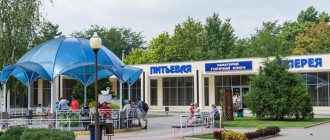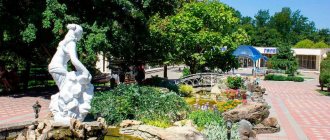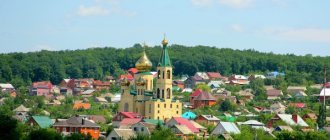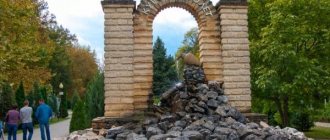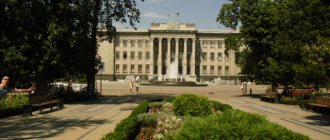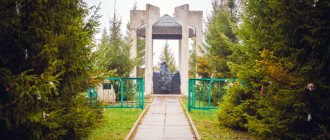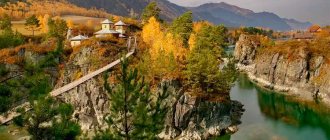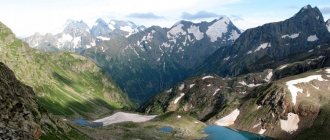Previously, on the lands where the city of Goryachiy Klyuch is located today, the Circassian tribe lived. One day they were awakened by a strange sound. People went outside and saw a fountain gushing out of the ground. The water was hot and smelled like rotten eggs. The tribe's inhabitants were frightened and decided to flee to the mountains.
In the panic and confusion, they forgot about the old man, who could not move independently due to rheumatism. Therefore, he lay in this water for several hours, after which he felt the strength to get up. The old man reached his fellow tribesmen and told them that the water was healing. People decided that this was a gift from God and, in gratitude, began to bring jewelry and coins to the source.
Until the 19th century, the village of Psyfab was located here, which means “hot water” in Adyghe. But as a result of the hostilities that unfolded in this territory, the locals were resettled from their native lands, and the village was named Alekseevsky Goryachiy Klyuch.
If you decide to visit Goryachy Klyuch on your way to the Black Sea coast, an overview of all the Black Sea resorts may be useful to you. Dzhubga will meet you first on the coast - find out if it’s worth spending a few hours exploring this village.
General information and history
Goryachy Klyuch is a resort in the Krasnodar region. Located in the foothills of the Caucasus range. Near Adygea, Krasnodar (60 km), the Black Sea city of Dzhubga (65 km). The distance to the capital is one and a half thousand km. And all along the well-maintained M-4 Don highway. There is a railway line through the city, and trains heading to and from Adler stop here.
View of Goryachiy Klyuch
The city began its history with the construction of a military hospital. Special taps with mineral water were installed, and buildings for the infirmary and service personnel were built. The lighting of the mineral springs and the hospital took place on July 15, 1864. And when the priest’s voice echoed into the gorge, a ray of sunshine broke through the rainy sky, covered with gray clouds, illuminating the clearing and the people who were there. Eyewitnesses took this as a sign from above and God's blessing.
July 15 is traditionally considered the city's birthday. The resort got its name thanks to underground springs of mineral water, the temperature of which reaches 62 degrees.
Hot key. Hydropathic clinic. Photo of Anastasia (https://fotki.yandex.ru/users/n2309/)
Thermal wealth
Psyfab is not an abbreviation, but the name of an Adyghe village, which at the beginning of the 19th century was located in the place where the city blocks are now located. It is translated into Russian as “hot water”. This name was inherited by the Russian settlement, which was founded in 1868.
Shortly before this, the Caucasian War ended, and most of the local population was deported. Soon a military hospital and bathhouse were built at the Psekup thermal springs. Then it was decided to create a park. This is how a new balneological resort appeared in the Caucasus. The main medicine here was local mineral water and clean air.
Previously, on the site of the city stood the village of Psyfab, named after the hot spring
At first the settlement was called Alekseevsky Goryachiy Klyuch. Administratively, it had the status of a “town”. At the beginning of the 20th century, its status was upgraded to a village. It became a regional center in the 60s. Now he controls 30 settlements - farms, villages, villages and towns. Currently, the city's population is just over 37 thousand people.
Ecology and climate of Goryachy Klyuch
Goryachy Klyuch is on the list of the cleanest cities in the world. Forests occupy more than 66% of the region's territory. There are no industrial production facilities in the immediate area. The main source of pollution is cars. But cars are prohibited from entering the resort part of the city. The road in front of the park ends with a barrier, where a vigilant security guard filters incoming cars, allowing only special vehicles and food products serving the sanatoriums into the territory.
Winter also happens in Goryachy Klyuch. Photo of Anastasia (https://fotki.yandex.ru/users/n2309/)
The climate is relatively mild, so sometimes the stories of the local population about cold winters seem exaggerated, especially for people who came, for example, from the Urals.
Hot summer! In July-August it is truly scorching here, outside it is about 35-45 degrees in the shade. If you are not constantly in the sun, then this heat can be tolerated quite easily. By the end of October, autumn begins. The leaves are turning yellow, the days are warm and sunny, much like Indian summer in the middle zone. Spring starts early. Already in February, the daytime temperature remains consistently above zero.
Psekups River and local landmark - Cockerel Rock
Great Phanagorian (Stalactite) Cave
The Great Phanagorian Cave, in the vicinity of Goryachiy Klyuch, was first described by the Turkish traveler Evliei Celebi in the 17th century. He said that in the central hall of the cave there was a huge bronze statue. Whether it was or not is no longer possible to establish. It is indisputable that the Phanagorian Cave is one of the most mysterious in the Caucasus.
According to legend, this natural tunnel used to stretch for 25 kilometers, right to the Black Sea coast, but then it turned out to be blocked. It is also known that the indigenous population had a special relationship with this cave - it was a sacred place, similar to the legendary Tibetan Shambhala.
During a tour of the Phanagorian Cave.
It is located in the valley of the Ayuk River, 12 km from the village of the same name. The entrance to the cave is round, about one and a half meters in diameter. A ten-meter-long narrow tunnel leads into the central hall. There are four halls in the cave. The total length of the cave passages is about one and a half kilometers. It ends with a double branch. One of the passages leading further is blocked, and the other becomes too narrow for further exploration. A small stream constantly runs along the floor of the cave.
Population of Goryachy Klyuch
The indigenous population as of 2021 is about 38,972 city dwellers. The birth rate has decreased over the past ten years, and the mortality rate exceeds it by about 10%. The main population growth is due to migrants. According to official sources, 700-800 people come here every year. According to local residents, this figure is much higher. For example, two years ago it was not difficult to rent a house even during the high season, but now even in winter it is not always possible to quickly find an option.
Panorama of Goryachiy Klyuch. Photo by https://fotki.yandex.ru/users/vkruglyj/
More than 85% of the indigenous population is Russian, mostly coming from Siberia and the Far East: some during Soviet times, and some later. The attitude towards visitors is warm and hospitable. Perhaps migrants are not accepted in other cities, but this does not apply to Goryachiy Klyuch. The Kuban people are like this in everything: unobtrusively, lightly and with humor. Long conversations are not in fashion here. Many people live on private farms, so there is a lot of work to do, everything needs to be done - to get offspring from poultry, to harvest a couple of crops from a small plot and to make preparations for the winter.
Summer in the city. Photo by https://fotki.yandex.ru/users/tat-shapovaliuk/
A culture of communication, sincerity, kindness and empathy are qualities that characterize the majority of residents of Goryachy Klyuch. Human attitude towards people is held in high esteem here. They will always help, give advice, explain the way and even show you around. Kubans are no strangers to the problems of strangers; they care about everyone. Nice!
There are few young people in the city. In search of work, most townspeople leave for Krasnodar, or even Moscow, where they settle, start a family, visiting Goryachy Klyuch to stay only during the holiday period. Middle-aged people and retirees live here permanently. Most of the city's guests have the impression that they come here mostly tired of the urban jungle and frosts of the northern regions.
Cenotaph of Hapach Lakshuka, 1717
An unusual monument - a pillar that simply emanates incredible antiquity; it is a cenotaph, that is, an obelisk over an empty grave. There are inscriptions on it in Arabic and Adyghe languages. And this pillar is made of pure marble. More precisely, it is a fragment of a column of an ancient temple, which was erected in the Byzantine Empire.
Cenotaph of Hapach Lakshuka.
This fragment was brought here by the Bzhedukh prince Aity-Khadzhi Khadzhimukov. In 1717, he, together with another noble highlander, Khapach Lakshuk, made a pilgrimage to Mecca. On the way back, Khapach died near Syrian Damascus, where he was buried. Dying during the Hajj to Mecca is considered a blessing from Allah. In memory of his friend, the Circassian prince erected this homemade obelisk. In any weather, the pillar is cold to the touch.
Districts and real estate of Goryachy Klyuch
The city can be divided into several districts. Each has its own advantages and disadvantages.
“Zarechye” is one of the very first districts of Goryachiy Klyuch. There are still old dilapidated buildings here, interspersed with modern two-story cottages and small country houses. The most unprestigious area of the city, and all because of the distance from the center (half an hour on foot) and the proximity of the railway station with its noise and bustle. The roads are bad, all full of holes and potholes. But there are also advantages.
The biggest plus for many, in particular for dog breeders, is the proximity of the forest and its desolation. It is here, a five-minute walk from home, that you can safely let your pets run around without the risk of meeting an overly impressionable mushroom picker. The steam locomotives and loudspeaker at the station are not particularly disturbing. Former residents of megacities are accustomed to the noise outside their windows, and indigenous residents do not consider the proximity of the station to be a disadvantage of their area. Minibuses run from the station, it takes 5-10 minutes to walk to the stop. The area is gasified, electricity is uninterrupted, a 3G modem provides a stable connection to the Internet, water is from a well in the yard, stove heating - beautiful!
Zarechye district, new bridge over the Psekups river
Prices for land and secondary housing here are the lowest in the city. One hundred square meters of land costs from 90 tr. A hut house (muzanka) with five acres of land and fruit trees will cost about 1.5 million rubles. with bargaining. A two-story brick five-room cottage with a land plot of 6 acres, a bathhouse, a garage and all communications (move in and live) costs 3.5 million.
In the northeast of the city there is an area called "The Fork". Construction is in full swing here, which in a couple of years threatens to result in a modern cottage community with central heating and water supply. Today it’s dirty, uncomfortable and noisy, but what can you do – construction! Gas and sewerage have already been installed, but the roads are only covered with gravel; they promise to lay asphalt when Kamaz trucks stop driving with building materials. There is a forest nearby. It takes 7-8 minutes to get to the center by car, there are minibuses.
"Razvilka" has the most houses for sale. Price per hundred square meters from 150 to 300 tr. Freshly built cottage with a total area of 110 sq. m, with all amenities and a landscaped yard, can be purchased for 4 million.
The area “Chepurkova Gora” does not resemble a mountain at all, it is rather a small hill. Recently, the Gorny sanatorium, owned by the well-known organization ZAO Ochakovo, was built nearby. Apparently, this is why sewerage was installed in the area. There is no gas, but they promise to gasify the area within two to three years. Electricity is supplied steadily. The roads are asphalted, but their condition leaves much to be desired. Heating by stove, water from a well or borehole. The advantage of the area is that even during the spring thaw, it is dry and clean. Elevation though. The center is a 15-20 minute walk away, there are minibuses.
One hundred square meters of land on “Chepurkova Mountain” costs 100-190 rubles. For a one-story brick house (S −140 sq.m.) with European-quality repairs, furniture and household appliances, autonomous water supply and heating, a garage and a gazebo, they are asking 6 million with negotiability. A residential dacha in the same area can be purchased for 990 rubles, and a two-room apartment in a new building for 3.5 million.
"Administration". The center is the center. There are mainly high-rise buildings here - old and new. There are few private houses and land plots, and they are quite expensive. For example, a five-room cottage, which has all the imaginable and inconceivable bells and whistles like a heated floor in the house, a capital basement and a sauna, costs 15 million. Prices for apartments vary greatly: in a new building the price per sq.m. is from 40 thousand rubles, secondary housing cheaper. The center is divided into several microdistricts, which are named depending on the proximity of certain establishments: “Traffic Inspectorate”, “Old Market”, “Hospital” and so on. Heating, water supply and sewerage are central here, the roads are good, and transport runs regularly.
Residential building near the city administration. Photo of Anastasia (https://fotki.yandex.ru/users/n2309/)
The “Sanatorium” area, also known as “Resort”, is the most prestigious area of the city. It's quiet, cozy and clean here. The buildings are very diverse. A dilapidated hut may well coexist with a luxurious mansion. There are all communications, many guest houses, mini-hotels and rooms for rent, which are in great demand in the summer. Real estate prices are not just greatly inflated, but, one might say, brutal! One hundred square meters of land here costs around a million; for the same price you can buy land on the seashore. Cottages from 20 million, simpler houses - from 15. The old market is nearby, there is a bus service.
Neighboring villages. Many visitors consider them as an option for permanent residence. Real estate here is much cheaper, the roads are good, regular minibuses run frequently, and it’s quieter, there’s not a large influx of vacationers. Just the thing for permanent residence!
Art. "Saratovskaya" is located 9 km from the city towards Krasnodar. The M-4 highway is a couple of kilometers away. Not very picturesque, but civilized. There is a hospital, shops, a market, schools and three kindergartens. There is a branch of Sberbank, an ATM, and several self-service stores accept plastic cards for payment. The houses are different. Those that are for sale are mostly tour-beams for demolition. The plots are large - from 15 acres and above. The heating is stove, gas is provided. Water on site, stable power supply. Almost all cellular operators receive a signal with confidence. Regular minibuses run frequently.
The village of Bezymyanoye is located south of the city. Forest, river, paved roads. There is a school and kindergarten, shops, and a recently built church. The only negative that disturbs the silence and charm of the area is the nearby Goryachiy Klyuch - Tuapse railway line. The border of the Caucasian Nature Reserve is not far away, so there are many tourists and vacationers in the village in the summer.
The villages of “Pyatigorsky” and “Mirny” are located very close to each other, the boundaries between them are rather conditional. Drive from Goryachiy Klyuch to the villages for about 7 km along the M-4 highway towards the sea. It is very beautiful in here. Mountains, a river and its own special microclimate. There are few shops, there is a school and a kindergarten. Mostly dachas and quiet family houses are located here. The road surface is asphalt in the center, primer closer to the outskirts. There is electricity, gas is in the plans, amenities are on the street.
The average price per hundred square meters of land in the nearest suburb of Goryachiy Klyuch is 60 thousand rubles. In villages located further away it’s cheaper.
When buying or renting real estate, it is better, of course, to contact the owner, although this is not easy to do. Even the advertisements, handwritten and glued to poles and bus stops, contain the intermediary's telephone numbers. And this brotherhood takes decent interest for services. Housing for rent - 100%! It’s better to travel yourself and ask around. Many owners announce the sale of their home with a sign on the gate indicating their phone number.
Rock Cockerel (aka Salvation Rock)
Another visiting card of the resort city is the Cockerel Rock (another name is the Salvation Rock). It rises above the surrounding area, descending with one steep side directly into the waters of Psekups. The rock got its name because of its peak, which looks like a cockscomb. There are several ancient (or stylized as ancient) legends about the rock. One of them says that in the Circassian village of Psyfab there was such a custom. Criminals sentenced to death were forced to climb this rock. The fact is that no one wanted to carry out the sentence. After all, the law of blood feud reigned, and the criminals also had relatives who, according to this law, were obliged to take revenge. Therefore, the execution of the sentence was given to nature. The criminal fell off the cliff and drowned in the river. If he managed to climb the mountain alive, then he was not executed, but simply expelled from the village. This is why the rock was called the Rock of Salvation.
Rock Cockerel (Rock of Salvation).
City infrastructure
Since Goryachy Klyuch is a resort town, there is everything for proper treatment and relaxation. Six sanatoriums that meet all modern standards. Here you can find swimming pools with mineral water, spas and massage parlors, fitness and gyms, and sanatoriums offer a wide variety of health treatments. The main specialization is diseases of the digestive system and the musculoskeletal system. You can purchase a sanatorium-resort card for a set of procedures, as well as for each service separately, without staying at the sanatorium. Many city residents take advantage of this, combining leisure time with health improvement.
Entrance to the Mountain Park. Photo by Tatyana Tkachenko (https://fotki.yandex.ru/users/ttp74/)
The main form of transport in the city is minibuses, but these are not the familiar yellow gazelles, but small, neat buses. Those driving around the city are new and beautiful, but those driving around the area are worse. They go quite often, the waiting time at the stop is often no more than five minutes. There are no conductors; the driver himself accepts the fare, which is 10 rubles around the city. There are many taxis, you can call through the dispatcher, or you can go out to the side of the road, raise your hand, and in a minute or two a brand new foreign car with characteristic checkered patterns will certainly stop next to you. Such pleasure costs from 70 rubles in the city.
Railway station GK. Photo https://fotki.yandex.ru/users/vkruglyj/
The roads, compared to the rest of Russia, are good. The main streets of the city are like glass, without a hitch! On the outskirts the situation is more sad. Right down to the roads covered with gravel and not covered with anything at all. It’s not dirty, not slippery, and you can drive everywhere if you’re careful. You won't find any traffic jams in the city even in summer. Lots of auto shops and auto repair shops. There are several gas stations.
There are plenty of schools and kindergartens, but, like everywhere else, there are queues. The salvation is numerous pensioners who are ready to earn extra money while looking after their children. Among them there are professional teachers with higher education. There is an art school and two sports schools. After graduating from school, you can continue your studies at a branch of Kuban State University, a medical college, a PU or a technical school. Or, as many do, leave their hometown in search of a better life.
Like every self-respecting city, Goryachiy Klyuch has its own newspaper, which, without further ado, was called “Hot Key”. There you can find all the city news and gossip, as well as job advertisements and housing rentals and sales. From time to time the newspaper is accused of copyright infringement. They say that this publication is stealing articles from the Internet. What about the newspaper? The dog barks, the caravan moves on... Two more advertising newspapers distributed free of charge: “Showcase” and “Gorodok”. There, among various advertisements, you can also find information about work.
Prices for utilities are as follows: cold water - 33.6 rubles / cubic meter, hot water - 165 rubles / cubic meter, sewerage - 26.60 rubles / cubic meter. Electricity - 3.23, in the pages 2.26. Gas - 50 rubles/month per person, garbage removal - 44 rubles per person. Wired Internet - 850 rub/month.
The city's housing and communal services do not always work perfectly. Photo by https://fotki.yandex.ru/users/vkruglyj/
Iveron Chapel
Before the entrance to Dante's Gorge, at the foot of Klyuchevaya Mountain, there is an Orthodox chapel in honor of the Iveron Icon of the Mother of God. Its structure seems to be built into the rock. The entrance to the chapel is decorated with a high arch, and its vault ends with a dome in Christian traditions. Every Friday, a solemn morning service is performed in front of the image of the Iveron Mother of God. Opposite the chapel, in the center of Mineral Glade, a memorial sign was erected in honor of the opening of the resort, which was attended by many important people, including the ataman of the Kuban Cossack Army.
Iverskaya Chapel.
Enterprises and work in Goryachy Klyuch
Several large self-service stores (mainly Magnit) and two markets provide city residents with products that are much cheaper than in the middle zone, and also of better quality. In season, vegetables cost pennies. For example, at the end of August, a kilogram of tomatoes, cucumbers, and peppers can be bought for 10 rubles. Nuts, fruits, honey are freely available. Southerners only accept fresh, chilled meat. No freezing! Pork from 165 rubles per kg, beef from 180.
There is work, vacancies are constantly posted, although locals complain that there is nowhere to work. Salaries, of course, cannot be compared with larger cities, but you can live. Many residents are employed in sanatoriums, boarding houses and hotels as waiters, administrators and other service personnel.
Tourist base Mezhgorye
Unskilled labor is also in demand at two mineral water bottling plants: Goryacheklyuchevskaya and Aroma-Yug. Salary from 8,000 rubles per month with a schedule of three days.
There is a construction organization “Terem”, which is constantly looking for welders, assemblers, laborers and drivers. The average salary at the enterprise is one of the highest - from 18 tr. per month, with an eight-hour working day and a five-day working week. There is an additional charge for processing. Payments are not delayed. Official employment, “white” salary, social package.
You can also get work from private traders, but there are no guarantees. If we get lucky. We need truck drivers, salesmen, cooks, hairdressers, security guards. Students and schoolchildren have the opportunity to earn pocket money from nearby farms. The work is varied - from planting and weeding plants to harvesting. Payment immediately in cash from 500 rubles for eight hours of work.
There is little demand for skilled labor. All managerial and “grain” positions have been occupied for a long time and tightly. Higher education can be useful only in the field of medicine, veterinary medicine, and pedagogy. These specialists have a chance to get a job. But the income is also small.
Many people go to Krasnodar to work. Salaries there are much higher than in Goryachiy Klyuch, and travel expenses are more than compensated for. The only negative is the endless traffic jams that plague Krasnodar roads.
Visitors often do not try to look for work, but immediately open their own business, which brings in a small but stable income. This is what they live by. Mini-bakeries, boutiques, beauty salons, and small farms are in the hands of private entrepreneurs.
Rock Mirror
This natural object, located in the vicinity of Maltsev Stream, got its name for a reason: a significant part of the rock forms a steep angle with the ground, literally 90 degrees, and its surface is absolutely flat and smooth. Climbers often train on the rock, honing their skills.
Rock Mirror.
Crime
The criminal situation in the city, as in all of Russia, is not great. In 2011, 6 murders were recorded, and in 2012 - already 11. In mid-December 2012, a taxi driver from Adygea was killed. I brought the client to Goryachiy Klyuch, contacted the dispatcher, said that he had problems and never got in touch again. A body with stab wounds was found in the city, not far from a burnt car.
In the summer, what most shocked the public was the murder committed by a 17-year-old young man who found out from a friend that no one would be home at night and broke into the apartment for the purpose of robbery. Unexpectedly, the criminal's friend returned home with his mother and found the thief. He was not taken aback and hit the hostess on the head with a frying pan several times, the woman died. The police were called by the son, who managed to rush out of the house. The criminal was detained; it turned out that the thief, suffering from kleptomania, had already been brought to justice in connection with thefts.
There are few visiting guest performers in the city. This contingent prefers to operate on the coast, where there are more vacationers with money. And what should they do in a quiet provincial town?
Domestic quarrels that lead to crimes, drunken fights, theft - it’s all there. Officials are caught taking bribes. Drug couriers are caught from time to time. Local businessmen steal timber and sell it for firewood - this product is in demand here.
Despite the disappointing statistics, the crime situation in the city is not too worrying. It is rare to see a drunk in the city during the day. Young people are reasonable and do not abuse alcohol or drugs. There is reliable security in nightclubs and restaurants, and you can go home by taxi. If you follow basic safety rules - don't wave a thick wad of bills in front of everyone, don't get drunk and don't wander the streets at night alone - you'll most likely avoid the risk of being robbed or beaten.
Psyfabe Fortress
On the northern slope of the Kokht ridge, which encloses the western outskirts of Goryachiy Klyuch, is located one of the oldest in the entire region - the Psyfabe fortress. More precisely, the ruins of this citadel are fragments of walls and foundations, overgrown with trees and bushes, and the remains of ditches. The fortress wall was more than 40 meters long and was about 3.5 meters thick. The entrance to the fortress was crowned by a huge rectangular tower, and in the northern part of the citadel there was a second polygonal tower with an observation deck. It is not known for certain who built the fortress, it is so ancient. There is a version that this was a settlement of ancient Christians, similar to those that existed in Abkhazia.
Ruins of the Psyfabe fortress.
Toadying
I would like to say special thanks to the head of the city, the administration and people who are not indifferent to their city for the cleanliness and order, for the well-groomed flower beds and green spaces. Many may object, but believe me, I have something to compare with. Although, of course, it is not pleasant to see clogged garbage cans that are rarely taken out and are not designed for such a number of residents. It's time to reconsider this issue. But shortcomings, mistakes, mistakes are always and everywhere. You just need to strive to have fewer of them. But a lot depends on you and me - ordinary people. Probably, many people see how “irresponsible elements” throw garbage, bottles, and cigarette butts wherever they please. Therefore, I propose to start with myself. Remember “Heart of a Dog”, where Professor Preobrazhensky spoke about the devastation? This statement is still relevant today.
Psekup dolmens
Throughout the Caucasus, these mysterious monumental structures of ancient people have long been found. More than twenty of them can be found in the valley of the Psekups River. One can only guess about the purpose of the dolmens. Scientists are inclined to conclude that these were either places of worship of ancient prehistoric religions, or funerary mausoleums.
Psekupsky dolmens.
